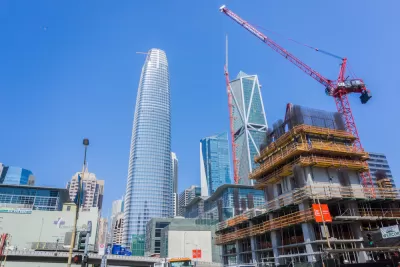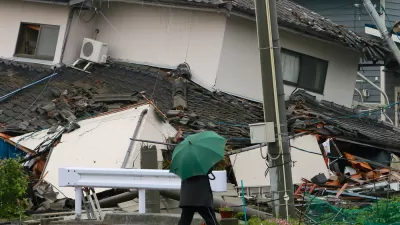The city has proposed tighter rules for new construction and a more active approach to securing existing tall structures from collapse.

Seismic activity has spooked San Francisco officials, who are now calling for stricter retrofitting measures, Rong-Gong Lin II writes. "First, a centerpiece of San Francisco's new downtown, the 58-story Millennium Tower, started sinking and tilting. Then last week, the city's new $2.26 billion transbay bus station was abruptly shut after cracks were found in two steel beams."
The city has released a list of over 150 tall buildings, including many constructed prior to modern seismic codes, as a prelude to assessing their need for retrofits. "The inventory comes with a sweeping proposal to more closely examine the city's skyline with an eye of making costly fixes to towers that could collapse amid major shaking. Officials are also calling for rules for new construction, aimed at preventing sinking of buildings as well as making tall buildings even stronger to resist wobbling in an earthquake."
These calls, Lin says, represent heightened rhetoric from several months ago, "when officials emphasized the difficulty in identifying the city's largest vulnerable buildings, such as those made of brittle concrete." Extant city laws, Lin continues, have not been particularly effective in requiring or spurring retrofits. "Current city law does require a seismic retrofit when two-thirds of a building's floors are renovated. But that almost never happens to tall buildings, when only a small fraction of the building undergoes construction at any given time."
FULL STORY: San Francisco Takes Unprecedented Step to Protect High Rises During Earthquakes

Planetizen Federal Action Tracker
A weekly monitor of how Trump’s orders and actions are impacting planners and planning in America.

Congressman Proposes Bill to Rename DC Metro “Trump Train”
The Make Autorail Great Again Act would withhold federal funding to the system until the Washington Metropolitan Area Transit Authority (WMATA), rebrands as the Washington Metropolitan Authority for Greater Access (WMAGA).

The Simple Legislative Tool Transforming Vacant Downtowns
In California, Michigan and Georgia, an easy win is bringing dollars — and delight — back to city centers.

The States Losing Rural Delivery Rooms at an Alarming Pace
In some states, as few as 9% of rural hospitals still deliver babies. As a result, rising pre-term births, no adequate pre-term care and "harrowing" close calls are a growing reality.

The Small South Asian Republic Going all in on EVs
Thanks to one simple policy change less than five years ago, 65% of new cars in this Himalayan country are now electric.

DC Backpedals on Bike Lane Protection, Swaps Barriers for Paint
Citing aesthetic concerns, the city is removing the concrete barriers and flexposts that once separated Arizona Avenue cyclists from motor vehicles.
Urban Design for Planners 1: Software Tools
This six-course series explores essential urban design concepts using open source software and equips planners with the tools they need to participate fully in the urban design process.
Planning for Universal Design
Learn the tools for implementing Universal Design in planning regulations.
Smith Gee Studio
City of Charlotte
City of Camden Redevelopment Agency
City of Astoria
Transportation Research & Education Center (TREC) at Portland State University
US High Speed Rail Association
City of Camden Redevelopment Agency
Municipality of Princeton (NJ)




























